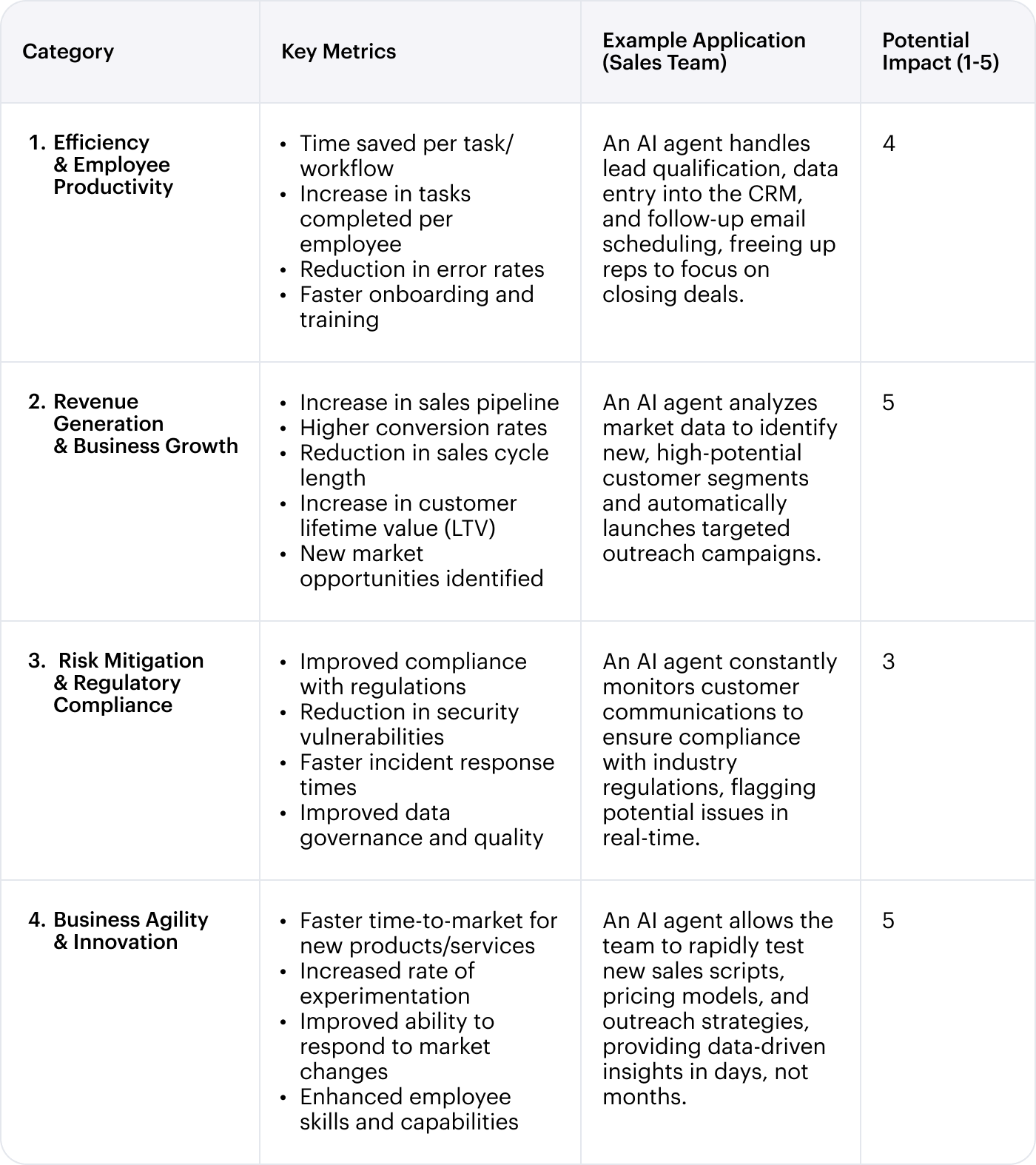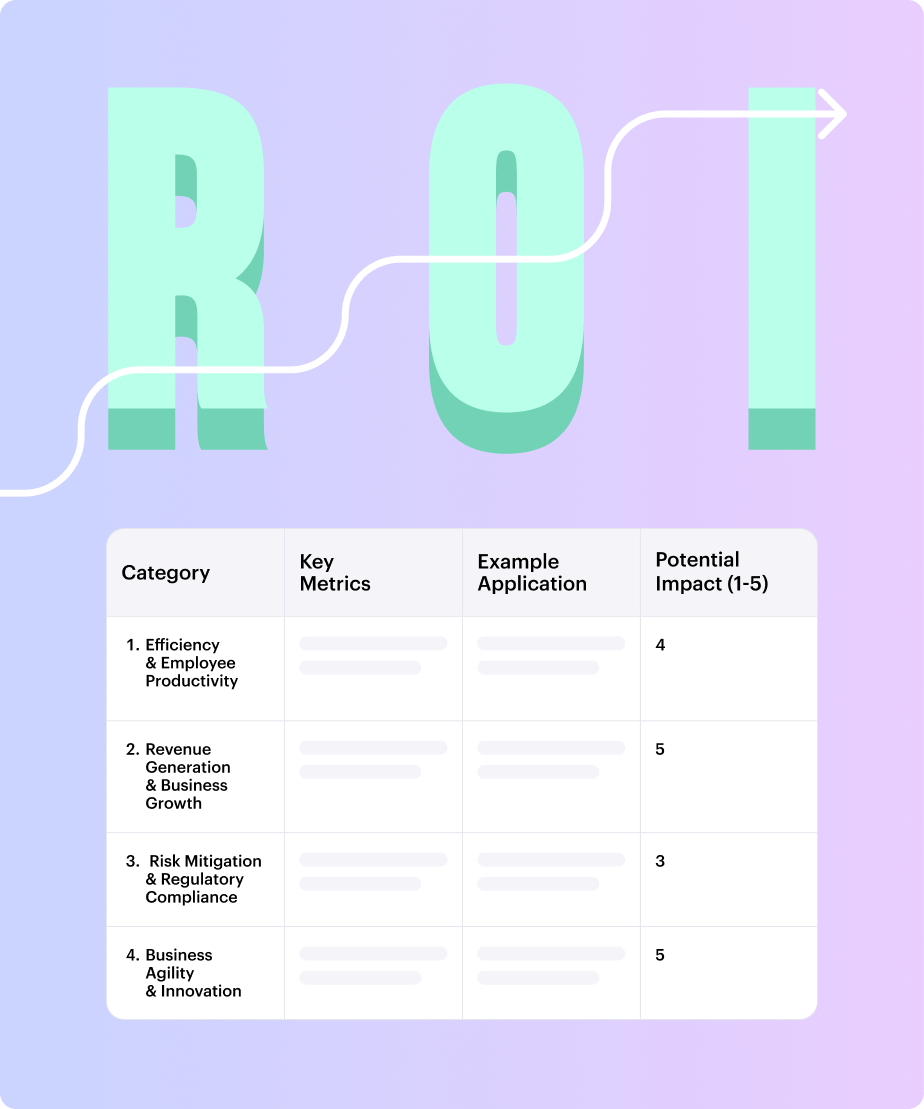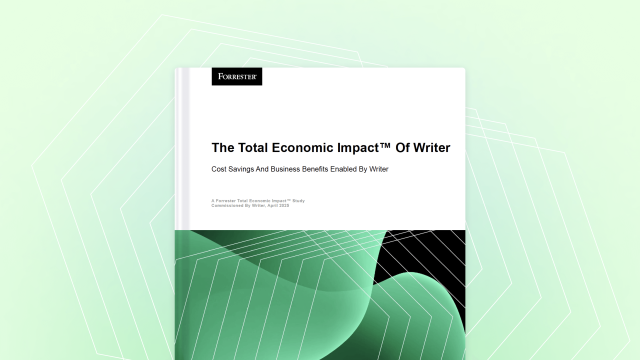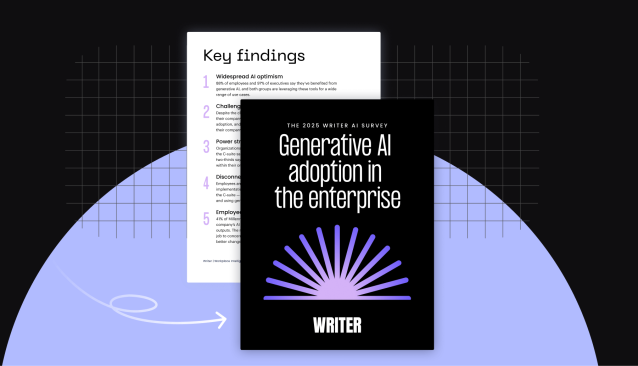AI in the enterprise
– 30 min read
AI ROI calculator: From generative to agentic AI success in 2025

The initial euphoria around AI investments has given way to what appears to be disillusionment, but this follows the predictable pattern of transformative technology adoption. We’re experiencing what Stanford’s AI Index identifies as the most transformative technology of the 21st century, comparable to the industrial revolution in its potential impact, and even more transformative than the internet.
Recent reports from 2025 paint a sobering but predictable picture — a staggering 95% of AI initiatives are failing to deliver their expected financial returns, according to research from MIT. Tech stocks have taken a hit, and boardrooms overflow with pointed questions about the real ROI of AI.
This isn’t just a vague feeling of disappointment. It’s a quantifiable problem with bottom-line impact. While 92% of executives are planning to increase their AI spending over the next three years, many organizations are doing so with a growing sense of unease. The paradox is clear — companies are investing more than ever in AI technologies that, for many, are not yet delivering on their promise. The result? A recent survey found that 42% of business leaders believe the process of adopting generative AI is tearing their company apart, creating internal division and power struggles.
But this isn’t cause for alarm — it’s exactly what Gartner’s Hype Cycle predicts. We’re in the natural period of experimentation that precedes technology maturation. During this phase, there will inevitably be spectacular successes alongside many failed experiments. The organizations that recognize this pattern and position themselves strategically will emerge as leaders when AI reaches mainstream adoption.
But the problem isn’t the technology. It’s how we measure its business value.
The traditional ROI models we’ve used for software and even for basic AI tools are failing us. They’re too narrow, too focused on simple task automation and cost savings from repetitive tasks. They don’t capture the exponential business value that comes from the next evolution of artificial intelligence — agentic AI.
Agentic AI is not just a tool — it’s an extension of your team. It’s a system that can understand complex business objectives, create a plan, and execute it with minimal human intervention. It’s the difference between a calculator and a financial analyst. And to measure its impact, we need proven strategies that go beyond traditional metrics.
This post will provide that framework. We’ll explore:
- Part 1: The foundation — how to measure the ROI of AI in a way that builds a foundation for successful AI transformation.
- Part 2: The strategic shift — why aligning AI investments with business outcomes is critical for staying ahead of competitors.
- Part 3: The agentic AI ROI framework — a new, four-part model for measuring the true business impact of AI-powered systems.
- Part 4: Framework in action — how global leaders across healthcare, financial services, and retail are achieving strong ROI with proven strategies.
It’s time to move beyond the AI bandwagon and the disillusionment. It’s time to start measuring what delivers tangible value.
Part 1: The foundation — measuring ROI of AI for long-term success
Before we can run, we need to walk. And before we can measure the ROI of agentic AI, we need to have a solid, modern understanding of how to measure the business value of AI tools that many organizations are already using.
The old way of thinking about AI ROI is simple: cost savings. How many hours of work did we eliminate? How many fewer people do we need to do a specific task? This is a factory-floor model, and it’s woefully inadequate for knowledge work where high-quality data and better decision making are critical.
A more human-centric approach to measuring AI ROI focuses on employee productivity and business value creation. Instead of asking, “How can we replace this person?” business teams should be asking, “How can we make this person, and their entire team, exponentially more effective?”
Let’s take a common example from marketing communications: a marketing team creating a new campaign.
The old model: Cost savings
Task: Writing ad copy
Time per ad: 30 minutes
AI tools time per ad: 5 minutes
Time saved: 25 minutes
ROI calculation: (25 minutes × number of ads × hourly wage) = Cost savings
This is a true, but very small, piece of the puzzle. It completely misses the bigger picture of business outcomes.
The new model: Business value creation
Now, let’s look at the same scenario through the lens of value creation and business impact:
Accelerated time-to-market: Business teams can now launch campaigns in real time. Instead of taking weeks to go from concept to launch, they can do it in days. This means they can react to market trends faster, capitalize on opportunities, and stay ahead of competitors. This ROI is more than saved hours — it’s increased market share and revenue gains.
Increased experimentation and optimization: Because creating variations of ad copy, images, and landing pages is now trivial, marketing teams can run dozens of A/B tests simultaneously. They can learn faster what resonates with their audience and double down on the winners. The ROI is a higher conversion rate and a lower customer acquisition cost.
Enhanced creativity and strategy: By automating repetitive tasks and offloading the formulaic parts of their work, teams have more time for what humans do best: strategy, creativity, and complex problem-solving. They can think about the bigger picture, explore new channels, and come up with breakthrough ideas. The ROI is stronger brand equity and long-term, sustainable profitability.
Improved employee engagement and retention: When you empower your team with AI-powered tools that help them do their best work, they’re more engaged and more likely to stay. The ROI is a reduction in hiring and training costs and a more innovative, resilient team.
When you measure AI ROI this way, you’re not just looking at the cost of AI tools; you’re looking at the total business impact. You’re moving from a defensive, cost-cutting mindset to an offensive, growth-oriented approach. This foundation is critical for building successful AI strategies as you move into the world of agentic AI.
Part 2: The strategic shift — aligning AI investments with business objectives
The move from generative to agentic AI isn’t just an upgrade— it’s a fundamental shift in how business leaders think about the role of artificial intelligence in the enterprise. It’s the difference between giving someone a power drill and giving them a team of carpenters who can build a house.
Generative AI is a powerful tool that can augment human capabilities and boost employee productivity. Agentic AI is a system that can take on entire workflows, from start to finish, with a level of autonomy that was previously the stuff of science fiction.
This isn’t a distant future. It’s happening now. The same 2025 reports that highlight the challenges with AI projects also show a massive push towards agentic solutions. The strategic imperative is clear — organizations that successfully make this shift will have a nearly insurmountable competitive advantage. The data from the MIT report supports this — companies that purchase specialized AI applications (which are increasingly agentic) see a 67% success rate, while those trying to build everything in-house with limited expertise are only succeeding 33% of the time.
What makes agentic AI different?
An agentic AI system has three key components that deliver high ROI:
Goal orientation: It can understand complex business objectives, not just specific commands. You don’t tell it what to do; you tell it what you want to achieve.
Autonomous planning: It can break down that objective into a series of steps, choose the right AI technologies for each step, and create a plan of action.
Execution and adaptation: It can execute that plan, use various resources (like web browsers, APIs, and internal software), and adapt its approach based on real-time insights it’s seeing.
Why is this critical for business success?
The shift to agentic AI is strategic because it moves the focus from task automation to outcome automation and delivers stronger financial returns.
Consider the marketing communications example from Part 1:
Generative AI: Helps business teams write ad copy, create images, and draft landing pages faster. The team is still running the process.
Agentic AI: You give it the business objective — “Launch a campaign for our new product, targeting this audience, with this budget, and this KPI.” The agent then does the research, analyzes the target audience, generates the copy and creatives, sets up the campaigns on the ad platforms, monitors the results, and optimizes the spend — all while providing regular updates to the human team.
The ROI in this scenario is not just about making marketing teams more efficient. It’s about creating an AI-driven system that can drive business outcomes at a scale and speed that’s impossible to achieve with human teams alone. It’s about building a true growth engine for the company.
This requires a new strategy for measuring ROI. It requires one that goes far beyond the foundational metrics we discussed in Part 1.
Part 3: The agentic AI ROI framework — measuring true business impact
To truly capture the business value of agentic AI, we need to expand our definition of ROI. The agentic AI ROI framework is a four-part model that helps business leaders measure the full business impact of these powerful AI-powered systems. It’s not just about what you save; it’s about what you gain in key areas that drive competitive advantage.
Here’s a template that business leaders can use to apply this framework in your organization and measure median ROI across different AI initiatives:
The agentic ROI matrix

Let’s break down each pillar:
1. Efficiency & employee productivity
This is the most straightforward category, but with a twist. We’re not just measuring time saved on individual repetitive tasks — we’re measuring the automation of entire, end-to-end workflows that deliver quick wins.
What to measure: How long did it take to complete a complex process (like onboarding a new customer or resolving a support ticket) before and after implementing AI applications? How many more of these processes can an employee manage now?
Why it matters: This is about scaling your operations without scaling your headcount. It’s about freeing up your most valuable employees from low-value, repetitive tasks so they can focus on high-impact, strategic initiatives that drive better decision making.
(Time saved per task × Number of tasks automated × Fully-loaded employee cost per hour) – Cost of AI solution = Efficiency ROI
Example: If an agent saves a marketing manager 5 hours per week on reporting, and the manager’s fully-loaded cost is $75/hour:
5 hours/week × 52 weeks × $75/hour = $19,500 in annual savings.
2. Revenue generation & business growth
This is where agentic AI becomes a true game-changer for achieving strong ROI. Because these AI-powered systems can operate 24/7 and analyze high-quality data at a massive scale, they can uncover revenue opportunities that human teams would miss.
What to measure: Are you seeing an increase in qualified leads? Is your sales cycle getting shorter? Are you able to enter new markets or launch new products faster with better business outcomes?
Why it matters: This is about turning your AI investment from a cost center into a profit center. It’s about building a system that does more than support your growth strategies, it actively drives them.
(New revenue generated + Incremental revenue from existing streams) – (Cost of AI solution + Associated program costs) = Revenue generation ROI
Example:
An AI agent that helps sales reps build customized proposals 50% faster could lead to more deals closed per quarter. If this results in $200,000 in new annual revenue:
$200,000 – $50,000 (AI cost) = $150,000 in revenue-based ROI.
3. Risk mitigation & regulatory compliance
In an increasingly complex regulatory environment, agentic AI can be a powerful ally for many organizations. It can monitor systems, enforce policies, and identify potential issues before they become major challenges with significant costs.
What to measure: Have you seen a reduction in compliance-related errors or security incidents? Is your data quality more accurate and reliable? Are you meeting regulatory compliance requirements more consistently?
Why it matters: The cost of a single compliance failure or security breach can be catastrophic to business objectives. With this, the ROI is about cost avoidance and protecting the long-term health and reputation of the business.
(Potential cost of risk event × Probability of occurrence without AI) – Cost of AI solution = Risk mitigation ROI
Example:
If there’s a 10% chance of a compliance error in financial reporting costing the company $500,000 in fines, and an AI agent reduces that probability to 1%:
($500,000 × 9%) = $45,000 in avoided risk value.
4. Business agility & innovation
The most powerful, yet hardest to quantify, benefit of agentic AI is the ability to make your business faster, smarter, and more adaptable in both short term and long-term scenarios.
What to measure: How quickly can you test a new idea or respond to a competitor’s move? Are your business teams developing new skills by working alongside AI applications? Can you adapt to market changes faster?
Why it matters: In a world of constant change, the most agile organizations win. This ROI is about building a more resilient, innovative, and future-proof company that can stay ahead of competitors and market disruptions.
(Value of faster speed-to-market + Incremental value from improved decision-making) – Cost of AI solution = Business agility ROI
Example:
Using an agent to accelerate product development and launch a new feature three months ahead of a competitor could capture an additional $300,000 in market share.
$300,000 (first-mover advantage) – $60,000 (AI cost) = $240,000 in agility-driven ROI.

Download the template
By using this four-part framework, business leaders can move beyond a simplistic cost-benefit analysis and start to understand the true, transformative potential of AI investments and their impact on the bottom line.
Part 4: The framework in action — how global leaders achieve strong ROI
While the principles of the Agentic AI ROI Framework are universal, the most powerful AI applications and metrics are highly industry-specific. Agentic AI isn’t a generic solution — it’s a precision tool designed to solve the unique, complex, and often regulated workflows of a particular sector.
Here’s how global leaders are applying this framework to achieve strong ROI and measurable business outcomes across different industries:
Healthcare: Optimizing patient care workflows with high ROI teams
Repetitive administrative tasks burden healthcare organizations because these tasks divert resources from patient care. WRITER’s healthcare clients like CirrusMD have achieved dramatic improvements in employee productivity by automating entire documentation and communication workflows with agentic AI systems that deliver tangible value.
Real-world use case: CirrusMD, a physician-first virtual care company serving over 13 million members, implemented WRITER’s agentic AI platform to automate two critical workflows: benefits navigation and clinical documentation. The AI system automatically reviews patient chat history, provides personalized health benefit recommendations covered by the patient’s plan, and generates complete SOAP notes for physician review — all while maintaining regulatory compliance.
Measured business outcomes:
- Employee productivity: 234% increase in physicians providing benefits recommendations to patients (compared to manual processes)
- Business agility: Development time reduced from over 12 months (in-house attempt) to under 6 months with WRITER
- Revenue generation: 30% patient engagement rate with AI-recommended benefits vs. 2-5% baseline engagement from traditional methods
- Risk mitigation: Automated clinical documentation reduces physician administrative burden while improving note quality and consistency
The WRITER advantage: As CirrusMD’s SVP Tanya Dillard notes, “WRITER’s Palmyra Med model is trained specifically for medical use cases, which means it delivers results we can rely on.” Our agentic solutions specifically help healthcare workflows through high-quality data requirements and deep medical context understanding, not retrofitted from generic AI tools.

How CirrusMD scales quality care with agentic AI
Learn More
Financial services: automating complex regulatory compliance
In heavily regulated financial services, regulatory compliance isn’t just a cost center — it’s a license to operate. WRITER’s financial services clients like Prudential have transformed their operations using agentic AI while addressing technical debt and data quality challenges across marketing and compliance workflows.
Client Success Story: Prudential’s marketing strategy team, led by Ashley Cheretes (Director of AI) and Lily Raymond (Marketing Strategy), implemented Writer’s agentic AI platform to automate content creation and customer analysis workflows. Their custom AI agents include a voice-of-customer analysis tool that transforms customer feedback into actionable insights while ensuring regulatory compliance across all marketing communications.
Measured financial returns:
- Employee productivity: 70% increase in speed to market for marketing campaigns
- Business agility: 40% boost in creative team capacity, enabling more strategic initiatives
- Risk mitigation: Enhanced personalization and compliance through automated customer feedback analysis
- Revenue generation: Improved marketing effectiveness through data-driven insights and faster campaign deployment
The WRITER advantage: WRITER’s approach to financial services goes beyond simple automation — we understand that regulatory compliance, data security, and brand consistency are non-negotiable requirements. Our agentic AI platform is built specifically for highly regulated industries with enterprise-grade security, audit trails, and compliance monitoring. As Prudential’s team demonstrates, our human-centered implementation approach won over initial skeptics by showing how AI enhances rather than replaces human expertise. WRITER’s custom agents don’t just create content faster — they ensure every piece meets regulatory standards while maintaining the nuanced messaging required in financial services marketing.

Prudential’s journey with WRITER: Past lessons, present practices, future possibilities
Learn More
Consumer packaged goods: AI-driven marketing and supply chain agility
CPG companies operate on thin margins and depend on brand velocity. WRITER’s CPG clients are using agentic AI to connect disparate data sources and automate complex decisions around product content, marketing communications, and regulatory compliance to achieve measurable business outcomes at a global scale.
Enterprise implementation: A Fortune 500 global CPG company with over 20 major brands implemented WRITER’s agentic AI platform across two critical workstreams — Product Description Pages (PDPs) through their content management platform, and comprehensive content creation for web, CRM, and regulatory compliance across multiple markets.
Quantified business impact:
Phase 1 – Content optimization platform (EU/US markets):
- Employee productivity: 337% efficiency gain in content creation workflows
- Risk mitigation: 64% reduction in cost per SKU through automated compliance and quality controls
- Revenue generation: Assuming 2% Net Sales Value (NSV) improvement from optimized content, translating to $50 million annual uplift potential
- Business agility: 4x more content produced, enabling faster market response and competitive positioning
Phase 2 – Comprehensive content automation (US market):
- Employee productivity: 10x more content created with 75% time savings across teams
- Risk mitigation: Over $2 million in efficiency gains through reduced agency dependency and streamlined review processes
- Business agility: Enabled 100+ associates with AI capabilities, transforming from weeks-long content cycles to days
- Revenue generation: Significant cost savings of $178 per SKU, with massive scalability potential across 160-200 SKUs
Human-centered transformation: What sets this implementation apart is its focus on empowering people, not replacing them. The CPG company’s approach combined technological excellence with comprehensive change management, training business teams to become “AI builders” who could create and customize agents for their specific workflows. This human-centered methodology resulted in organic adoption across multiple business units and geographies.
Real-world agentic capabilities: The system demonstrates true agentic behavior by autonomously analyzing brand requirements, retailer specifications, and regulatory compliance needs, then generating optimized product descriptions, marketing copy, and regulatory documentation — all while maintaining voice consistency across 30+ languages and multiple market requirements.
The WRITER advantage: As the CPG company’s leadership noted, “Scaling AI requires technology plus deep partnership.” WRITER’s full-stack approach provided not just the technology platform, but the strategic partnership, change management expertise, and proven methodologies needed to transform content operations at enterprise scale while maintaining the human creativity and strategic thinking that drives brand success.

Beyond automation: How agentic AI is reshaping CPG
Learn More
Retail: AI-powered personalization at scale
For retailers, personalization drives loyalty and lifetime value. WRITER’s retail clients like Adore Me are executing hyper-personalized customer engagement campaigns and automated content creation that transform entire business operations while addressing key areas like international expansion and marketplace optimization.
Implementation example: Adore Me, a direct-to-consumer intimate apparel company and certified B Corporation, implemented WRITER’s agentic AI platform across multiple critical workflows — SEO-optimized product descriptions, personalized stylist notes for their home try-on service, and automated marketplace content creation for third-party retailers like Amazon, Target, and Walmart.
Measured results:
- Revenue generation: 40% increase in non-branded search traffic from SEO-optimized product descriptions
- Business agility: International market expansion from months to 10 days (Mexico launch) processing 2,900 product descriptions in minutes
- Employee productivity: Marketplace content creation reduced from 20 hours per month to 20 minutes, and stylist note writing time reduced by 36%
- Risk mitigation: Automated compliance with different marketplace requirements while maintaining voice consistency across all channels
Real-time value creation: The system demonstrates true agentic capabilities by autonomously generating marketplace-specific product descriptions that meet each retailer’s unique requirements. For example, when expanding to Mexico, the AI agent not only translated content but also added cultural context and local market insights specific to Mexican consumers shopping for intimate apparel.
Human-centered innovation: What sets Adore Me’s approach apart is their creation of “prompt coordinators” — business users who bridge the gap between technical teams and end users. As former SVP of Strategy Ranjan Roy explains, “The end user will come up with the best solution to their problem. WRITER AI Studio’s no-code platform makes it possible for the actual end user to build agents.” This approach reduced agent development time from four months to days or weeks.
The WRITER advantage: WRITER’s AI Studio provides both no-code tools for business users and the WRITER Framework for developers, enabling smooth collaboration. As Roy notes, “WRITER doesn’t follow trends that are happening in the industry, but actually creates products and infrastructure that lead the way.” The platform’s flexibility allowed Adore Me to create everything from simple speaker bio generators to sophisticated international expansion workflows — all while maintaining security and compliance standards essential for retail operations.

Retail reimagined: Adore Me accelerates time to market with WRITER AI Studio
Learn More
The WRITER way: Proven strategies for AI transformation
What sets WRITER apart is our systematic approach to successful AI transformation. We don’t just provide AI technologies — we provide proven strategies and expertise for achieving measurable ROI across different industries and business objectives.
Validated results: According to an independent Total Economic Impact™ study conducted by Forrester Consulting, organizations using WRITER achieved 333% ROI and $12.02 million net present value over three years, with payback in less than six months. This comprehensive study analyzed real customer implementations across financial services, healthcare, software, and other industries to validate WRITER’s business impact.
Phase 1: Strategic ROI assessment and planning
- Comprehensive workflow analysis using our proprietary assessment tools that identify high ROI opportunities
- Identification of high-impact agentic opportunities specific to your industry and business objectives
- Custom ROI projections using the four-part framework with realistic timelines for financial returns
- Risk assessment and mitigation planning to address technical debt and infrastructure challenges
Proven impact: Forrester found that WRITER customers achieved 200% improved labor efficiencies, with teams completing tasks faster and focusing on strategic initiatives rather than routine work.
Phase 2: Pilot development and quick wins
- Rapid prototyping of agentic workflows using WRITER’s AI-powered platform
- A/B testing against existing processes to validate ROI assumptions and measure gains
- Integration with your existing technology infrastructure without disrupting critical operations
- Performance monitoring and optimization to ensure data quality and business outcomes
Measured results: Organizations experienced an 85% reduction in review times and a 65% faster new hire onboarding, creating immediate productivity gains while building confidence in the AI transformation.
Phase 3: Scale and optimize for long-term success
- Enterprise-wide deployment with comprehensive change management to ensure employee engagement
- Continuous ROI measurement and reporting across key areas
- Ongoing optimization based on real-world performance data and insights
- Strategic expansion to additional use cases and business teams to maximize investment returns
Financial impact: Companies achieved significant cost savings, including a 50% reduction in agency scope (saving $5 million over three years) and legacy system consolidation that freed up one full-time equivalent and saved $492,400 in maintenance costs.

Download The Forrester Total Economic Impact™ study on WRITER
Learn more
From AI ROI to AI-driven business transformation
The conversation around AI investments represents a pivotal moment in business history. We’re witnessing the adoption curve of what experts recognize as the most transformative technology to appear after the industrial revolution. The organizations that succeed in this new era will be the ones that understand this isn’t a trough of disillusionment, but rather the natural experimentation phase that precedes widespread transformation.
Recent research from McKinsey’s State of AI report reveals what distinguishes organizations achieving measurable impact from those struggling to articulate value: “Our survey analyses show that a CEO’s oversight of AI governance — that is, the policies, processes, and technology necessary to develop and deploy AI systems responsibly — is one element most correlated with higher self-reported bottom-line impact from an organization’s gen AI use. That’s particularly true at larger companies, where CEO oversight is the element with the most impact on EBIT attributable to gen AI.”
This requires a strategic approach that goes far beyond individual AI projects:
Align AI to C-level strategy: AI transformation must be driven from the top, with clear governance structures and strategic alignment. Organizations achieving the highest ROI treat AI as a core business capability, not an IT initiative.
Build organizational AI competencies: Success requires developing internal capabilities to identify, implement, and scale AI solutions. This includes training business teams to become “AI builders” who can create and customize agents for their specific workflows.
Adopt a strategic measurement framework: Move beyond simple cost-benefit analysis to comprehensive frameworks that capture efficiency gains, revenue generation, risk mitigation, and business agility across all business functions.
The data is clear — simply investing in AI technologies is not enough. Success requires clear AI strategies, C-level governance, and a modern framework for measuring what delivers tangible value to business leaders. Just as digital leadership has paid dividends for years, AI leadership will determine competitive advantage for the next decade. The companies that get this right won’t just see financial returns on their AI investment — they’ll see a fundamental transformation in how their business operates, innovates, and wins. They will be the global leaders of the agentic enterprise, staying ahead of competitors and market challenges through strategic AI adoption.
Ready to calculate your AI ROI and drive business transformation?
Download our free agentic AI ROI calculation guide and discover how your organization can achieve strong ROI with agentic AI. This comprehensive toolkit includes:
- Complete ROI measurement framework with the four-pillar Agentic ROI Matrix for measuring efficiency, revenue generation, risk mitigation, and business agility
- Detailed ROI formulas for each pillar with step-by-step calculations to quantify your AI investment returns
- Business function templates covering Marketing, Sales, Customer Support, R&D, Operations, HR, Finance, and Legal & Compliance use cases
- Real-world examples showing how AI agents deliver measurable impact across different business workflows
- Proven results validation from Forrester research showing 333% ROI and $12.02 million NPV over three years
Schedule a strategic consultation with our AI transformation experts to:
- Assess your current AI maturity and ROI measurement capabilities across key areas
- Identify the highest-impact agentic AI opportunities in your organization
- Develop a custom implementation roadmap with projected financial returns and timeline
- Learn from real client case studies in your industry with measurable business outcomes
Explore WRITER’s agentic AI platform and see how organizations across healthcare, financial services, retail, and technology are transforming their operations while achieving bottom- line impact through AI-driven automation and better decision-making.
Frequently asked questions about AI ROI
What is AI ROI and how do you calculate it?
AI ROI (Return on Investment) measures the financial benefits of artificial intelligence initiatives compared to their costs. To calculate AI ROI, use this formula: (Benefits – Costs) / Costs × 100. However, measuring AI ROI requires a comprehensive framework that goes beyond simple cost savings. The most effective approach uses four key areas: efficiency gains, revenue generation, risk mitigation, and business agility. According to Forrester’s Total Economic Impact ™ study, organizations using WRITER’s agentic AI platform achieved 333% ROI with $12.02 million net present value over three years.
How long does it take to see ROI from AI investments?
Organizations implementing WRITER’s platform typically see payback in less than six months, according to Forrester’s independent research, with immediate productivity gains like an 85% reduction in review times and a 65% faster employee onboarding. The key is starting with high-impact, low-risk use cases that deliver quick wins while building toward more complex implementations.
What’s the difference between generative AI ROI and agentic AI ROI?
Generative AI ROI typically focuses on task-level automation and time savings, such as writing content faster. Agentic AI ROI measures outcome-level automation where AI systems complete entire workflows autonomously. For example, generative AI might help write product descriptions faster, while agentic AI can analyze market data, generate optimized content, update multiple retailer systems, and alert logistics teams — all automatically. This difference explains why agentic AI delivers significantly higher ROI through comprehensive workflow transformation.
How do you measure AI ROI in regulated industries like healthcare and financial services?
Regulated industries must measure AI ROI across compliance, risk mitigation, and operational efficiency. In healthcare, CirrusMD achieved a 234% increase in physician benefits recommendations while maintaining regulatory compliance. In financial services, Prudential saw 70% faster time-to-market for marketing campaigns while ensuring all content met regulatory standards. The key is using AI platforms built specifically for regulated industries with audit trails, compliance monitoring, and industry-specific guardrails.
What are the biggest challenges in proving AI ROI to executives?
The main challenges include — (1) focusing only on cost savings instead of value creation, (2) lack of baseline measurements, (3) difficulty attributing results to AI vs. other factors, and (4) underestimating implementation costs. Successful AI ROI measurement requires establishing clear metrics before implementation, using a comprehensive framework that captures all value streams, and working with experienced AI partners who understand change management and adoption challenges.
How do you calculate ROI for AI projects across different business functions?
Different business functions require different ROI calculations. Marketing teams measure increased conversion rates and faster campaign deployment. Sales teams track shorter sales cycles and higher pipeline generation. Customer support measures reduced resolution times and improved satisfaction scores. Operations focuses on cost reduction and process efficiency. The most effective approach uses function-specific metrics within a standardized four-pillar framework covering efficiency, revenue, risk mitigation, and business agility.
What ROI should I expect from implementing agentic AI?
ROI expectations vary by industry and use case, but Forrester research shows organizations can achieve 200-400% ROI from agentic AI implementations. Typical results include — a 200% improvement in labor efficiency, a 50% reduction in agency costs, an 85% faster review processes, and a 65% quicker employee onboarding. The key is starting with proven use cases and scaling systematically.
How do you justify AI investment costs to get budget approval?
Build a compelling business case using — (1) industry benchmarks showing proven ROI from similar implementations, (2) specific use cases with quantified benefits and realistic timelines, (3) risk mitigation value including compliance and competitive advantages, and (4) pilot proposals that demonstrate quick wins before full investment. Include both quantified benefits (cost savings, revenue increases) and strategic advantages (faster innovation, improved agility). Use data from independent research, like Forrester TEI studies, to validate projections.
What are the hidden costs of AI implementation that affect ROI?
Hidden costs include — change management and training (often 20-30% of total costs), data preparation and integration work, ongoing maintenance and optimization, compliance and security requirements, and the opportunity cost of employee time during implementation. Many organizations underestimate the effort required for successful adoption. Working with experienced AI partners who provide comprehensive implementation support, training programs, and proven methodologies helps avoid cost overruns and ensures successful ROI realization.
How do you measure the business value of AI beyond direct cost savings?
Business value extends far beyond cost savings to include — faster time-to-market enabling competitive advantages, improved decision-making through better data insights, enhanced customer satisfaction leading to higher lifetime value, increased employee satisfaction and retention, and greater business agility for responding to market changes. These benefits are often larger than direct cost savings but require comprehensive measurement frameworks and longer-term tracking to fully quantify their impact on business performance.




